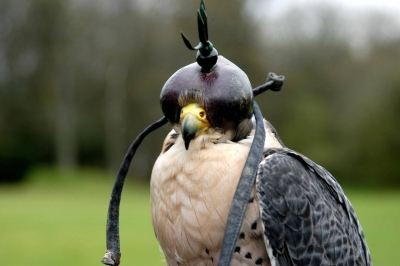
In falconry the birds are trained to catch prey and bring it back to the handler.
The falcon is hooded so that it is not distracted as it perches on the gloved wrist of the falconer. When the hood is removed the bird takes off a search of game.
The purpose of the falconry hood is to control the moments a trainer and bird of prey interact so that the bird recognizes the trainer’s role in positive and neutral moments and minimizes negative stimuli. This means that the amount of time the bird is hooded is not a constant and can fluctuate in response to the trainer’s growing reinforcement value. Because birds of prey don’t have many social reinforcers and the relationship does rely largely on reinforcers such as food, the trainer can avoid filling up the raptor’s crop by transporting it with a hood, thus removing the need to deliver food for staying on the glove and not try to fly off, either in response to a scary stimulus or in anticipation of its next opportunity.
A falconry hood can be a critical tool in preventing problems because it can be so hard, if not impossible, to train a raptor to be calm in all circumstances. This means when unpredictably scary stimuli arise and we have a raptor with us, it can associate us with the fearful situation, whether we choose to restrain it on the glove or it flies off, leaving us in a lose-lose scenario. In the case where we do have food that we can use to counter condition the bird of prey to stressful stimuli, we are limited by the raptor’s appetite, and if it is fully flighted and able to fly, there is a good chance we can overfill it and lead to a situation where it loses the motivation to stay on the glove as well. The same can also be said for changing and unpredictable circumstances when we can no longer rely on food motivation to help us work the bird through in a calm manner.
Credit : Avian Behaviour
Picture Credit : Google




